Posted by Steve Price on 05-27-2003 11:17 AM:
Color and Age?
Hi Tom,
One of the statements in your essay that caught my eye is the
correllation of a high contrast, broad palette with age in Belouch group
weavings. I don't recall seeing anything like that before, and wonder if you
would mind expanding on it.
We've had a couple of Salons dealing with
aspects of Belouch group weaving; Salon
86, about striped field Arab Belouch rugs, and Salon
32, about some of effects of the low contrast palettes on our perception of
the rugs. But the subject of basing age attribution on palette or color use
hadn't come up.
Thanks,
Steve Price
Posted by Tom Cole on 05-27-2003 10:40 PM:
In my experience, Baluch rugs with little contrast, dark and murky are
usually later pieces. That is not to say that all dark Baluch pieces are late,
note image #5 in the group of 12 at the end of the Salon.. an earlier, older
piece. But if you compare that image with the one I identify late in the piece
of writing, the differences are like night and day. #5 is clearly delineated,
clearly and precisely drawn, while the piece in the essay is not a clearly drawn
weaving. Certainly the Seistan pieces are easily dated by colour and actually,
the others are as well. Variations, subtle shades of different colours contrast
with each other in older Khorassan weavings as well. Later Baluch weavings from
Afghanistan will tend to be colourless and bland, or identified by the presence
of synthetics, or worse yet, both.
Posted by Patrick Weiler on 05-27-2003 11:50 PM:
Lots 'o Color
Tom,
Here is a Baluch weaving, probably used as a pack band, with lots
of color. It has a deep green, a saturated eggplant and a tip-faded blue - along
with natural brown and white. It is 64" long, 162cm, and 4" wide, 10cm. Some of
the colors have receded from oxidation, including the blue and the white. The
knots are asymmetric, open left, at about 8x8, 36kpsi.
It has (or had) a
flatweave section at one end of 1/2 inch of egglant, green and red, then plaited
into ties that are now mostly gone. The other end is flatweave eggplant folded
over and sewn down. The warp is white Z2S wool, with moderate to severe warp
depression. The weft is light and dark wool, 2 shots. The selvage is two bundles
of two warps, interlaced with the ground wefts and reinforced with red and green
braiding.
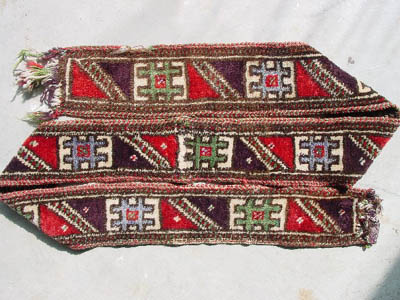
A
close-up of the front shows the dice design in the middle of the tic-tac-toe
motif. The dice spots are the tip-faded blue.
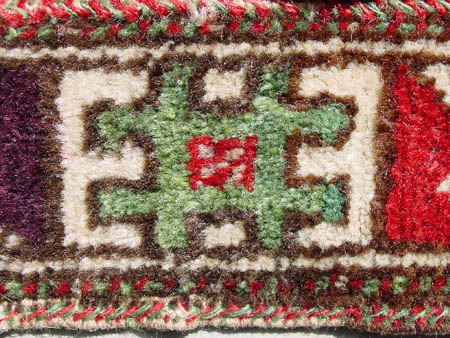
You can see a slightly darker
blue from the back, along with the depressed warp construction:
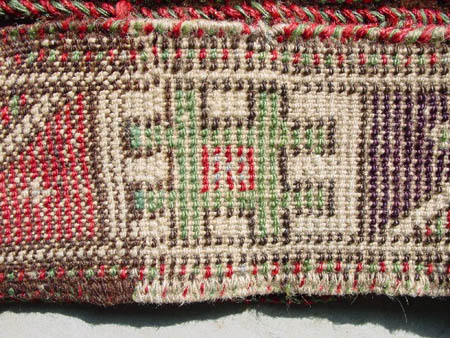
This is obviously not a
truly old, museum piece, yet it is exuberantly colorful. Does this indicate the
provenance, the relative age or that the weaver just used brighter colors for
this particular piece? Or, as you said, "Later Baluch weavings from Afghanistan
will tend to be colourless and bland, or identified by the presence of
synthetics, or worse yet, both."
Patrick Weiler
Posted by Tom Cole on 05-28-2003 12:30 AM:
This is a Seistan region piece. The statement that all late pieces are
colourless is not necessarily true.. but all colourless pieces are late... that
much is true in my experience. The tip faded blue may be an aniline dye?? You
tell me, difficult to see.
Posted by Patrick Weiler on 05-28-2003 09:40 AM:
Can't say for sure
Tom,
I had wondered if this blue was indgo-sulfonic, but that turns
out to apparently not be the case. The blue is the only color in this piece that
has faded. Usually we associate fading with fuchsine, a purple color. The purple
in this piece is undiminished. Perhaps these are all chrome colors except the
blue? The surface of the blue looks almost mottled from the front, like
stone-washed jeans, but interestingly it is the same light blue from the back -
it is only darker in the depth of the pile. Most faded colors retain most of
their original hue on the back.
I would have to say this is one dye that was
not successful, but certainly mysterious.
Patrick Weiler
Posted by David R.E. Hunt on 06-08-2003 12:08 AM:
Comparison and Contrast
Tom Cole and All- Thank you so much for the imformative salon.Yes, it does
seem that the Balouch ascription is rather tenuous at best, and I think it
apparent that several distinct weaving peoples and/or cultures are relegated to
this label if for nothing more than that their true identity is unknown. Far be
it for me to ascribe provenance based solely upon palette alone-takes a more
experienced man than me-so I will limit my commentary to those aspects with
which I am familiar, and submit a comparison and contrast of two different
weavings and those aspects of their coloration which I find interesting
In
the first instance I have here a so called Balisht in the typical late and low
contrast colors.
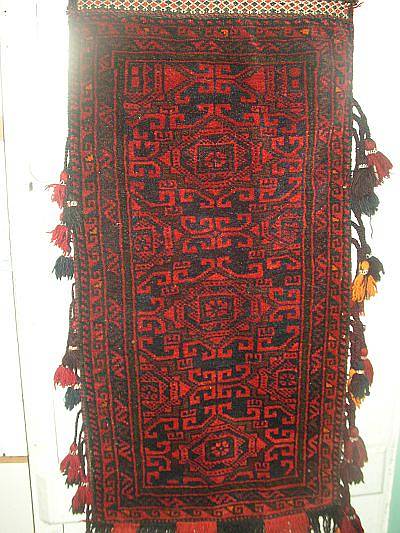
Under normal indoor lighting conditions this bag is a
glowering,Mayan petroglyph of a rug with it's most primative yet effective
rendition of a Turkmen gul in deep red on a dark, seeming nearly black ground.
Yet when taken outside into
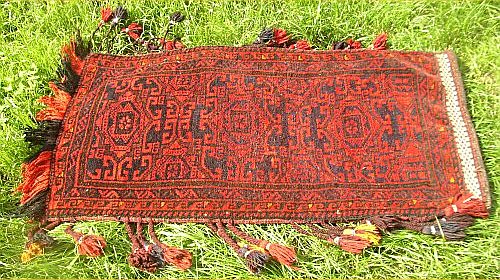
the full light of a bright day, an interesting transformation
takes place and the formerly subdued green,from what appears to be a natural
brown wool overdyed with green, along with the complementary yellow add a new
dimension to the repetoir of the palette. Not so dark after all. And while most
coarsely knotted, containing much goat hair, and exhibiting a limited range of
colors, the wool seems of high quality and with much sheen, making it hard to
photograph. The red is a particularly nice color with much abrash and hence an
imparted sense of depth, which I believe makes for a most ruggedly handsome
bag
This second rug I submit as a direct counterpoint to the first,
exemplifying the limitations of this Balouch attribution, for it is
impossible,it seems to me, that the same people and same weaving culture
produced both of these carpets Where the former is so coarsely knotted, the
other is most fine. While the former consists of at most seven colors, the
latter has double that number. The former wool and goat hair, yet the latter
displays silk accents as well. Yet both in essence utilize the same colors,
varying shades of red and brown, but with the overdyed green of the Balisht
serving as the primary dark,where as in the prayer rug the blue serves this
function and the overdyed green acts as a most effective counterpoint to the
yellow of the camel colored ground. Where the palette of one is rustic and
limited, the other is sophisticated, not owning so much to a greater number of
colors, but to a subtle selection of a number of complementary shades of like
colors. Even the silk lites are in the most of pastel shades, and not readily
discernable but upon close scrutiny(clue?).
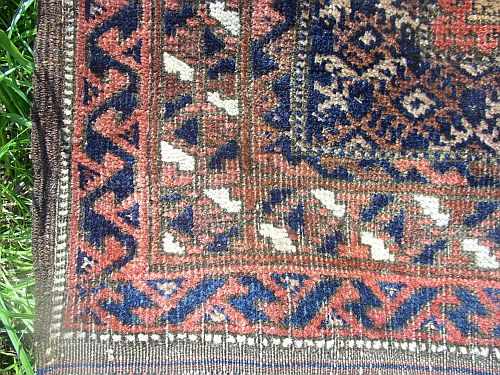
Up close these colors may seem
rather drab, but step back.
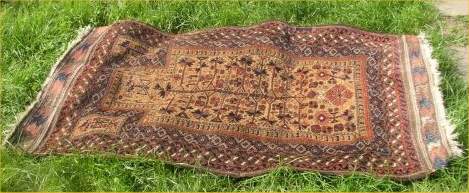
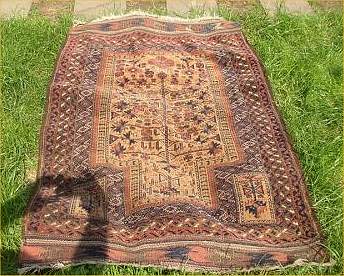
But
who did make these two rugs? The Balisht strikes me as resembling that which
P.R.J. Ford describes as Taimani and would hail from Afghanistan if I am not
mistaken. The prayer rug I am not so sure about, post Craycraft's Balouch Prayer
Rugs, and I would think could hail from Turkestan or N Afghanistan- but I don't
really know -Dave







